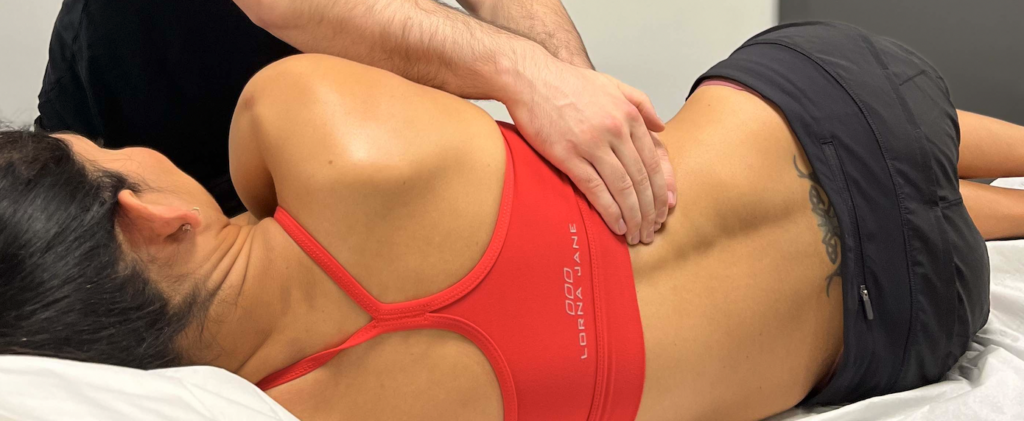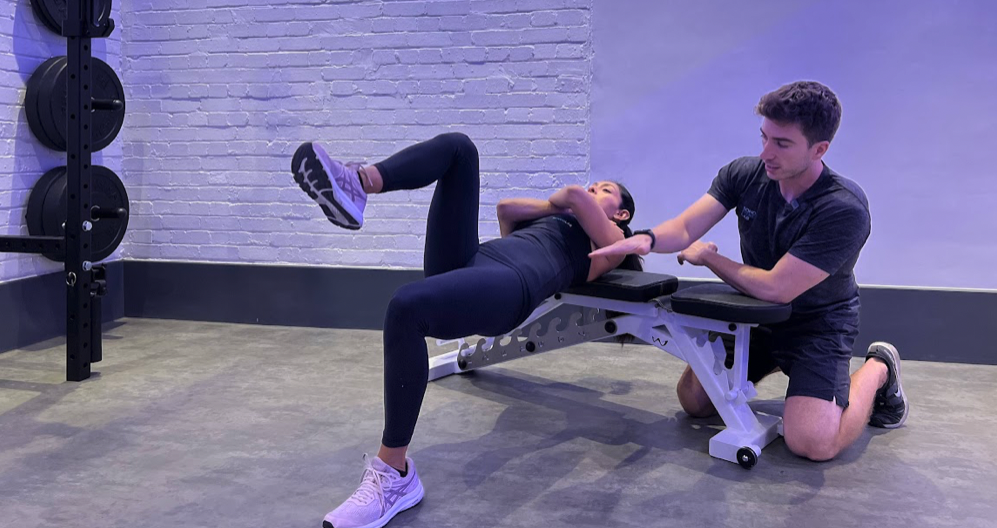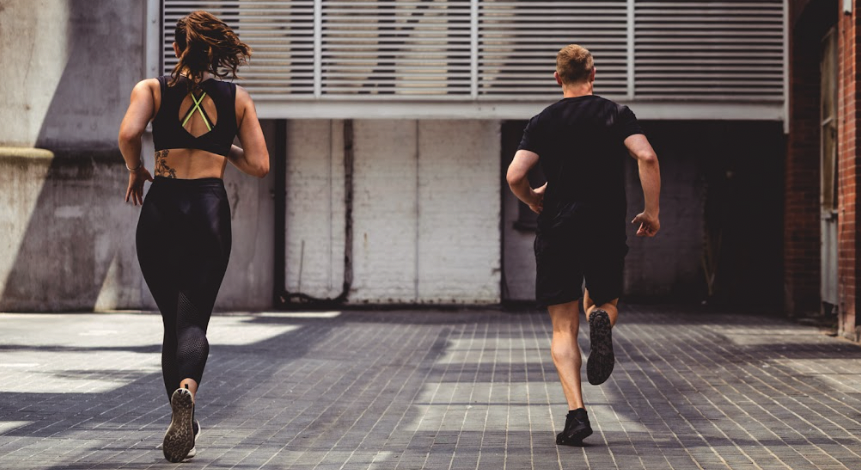This is part of our series of blogs on the posterior chain. In this blog, we’ll take a detailed look at the consequences of a weak posterior chain and why this kind of weakness can occur.
Weak posterior chain symptoms
The posterior chain makes up all of the muscles that are on the back (posterior) of your body. Having and maintaining a strong posterior chain will enable you to move correctly and efficiently and will ensure that injuries across the board are minimised.
Whilst we can never favour one muscle group in the body due to the importance of every muscle group working together as a whole, the posterior chain is of particular importance due to the fact that it is so often neglected.

In this article, we will cover some of the common causes of having a weak posterior chain, some of the common injuries and most importantly, what you can do about it to help strengthen the posterior chain and remain injury free, strong and healthy for life.
Weak posterior chain: Knee pain
A weak posterior chain can often lead to knee pain. As most now know, the posterior chain is grouped into three major muscle groups, the back, the glutes and the hamstrings, all of which contain a number of muscles within each group.
When it comes to knee pain specifically, having strong and well-functioning hamstrings and glutes is essential in avoiding unnecessary aches and pains and overtime injuries. The glutes are big stabilisers of the lower limbs as a whole, and the hamstrings (mainly responsible for extending the leg backwards (think kicking someone who is behind you).
With specific regards to the glutes in knee pain, if you have weak glutes, you will likely have poor stability and control of your hips, lower back and lower limb areas. Gluteus maximus, medius and minimus play a key role in ensuring the hips remain strong and stable which directly transfers to a stronger and more stable lower back and a strong and more stable overall lower limb area.

As the knee is not actually physically attached directly to the bony structures of the body and is instead ‘free floating’ and held in place by muscles (mainly the quadriceps but helped by hamstrings and other lower leg muscles) the strength and stability of the glutes play a vital role in ensuring the knee is kept strong and sturdy in any daily movements you complete. Think of bending down to pick up dishes from the dishwasher, running for the bus, or walking down or up the escalator. All of these require stability of the knee joint as a whole, and a lot of this is driven by the glutes and the hamstrings.
Should you not gain the stability and support required from your posterior chain, you are likely over a period of time to experience pains and niggles, which can, if not addressed, lead to more serious injuries such as patella tendonitis, misaligned kneecap, damaged meniscus, bursitis, stress on the ACL, PCL and MCL ligaments.
In order to fix this and to avoid any unnecessary pains, train your posterior chain to become strong and functional using resistance-based exercises which in turn will help build strength and muscle mass around the glutes, hamstrings and lower back areas.
Weak Posterior Chain: Lower back pain
Weak posterior chain and lower back pain all cases go hand in hand. As we mentioned above, the posterior chain is broken down into three major sections in most cases, the lower back itself, the glutes and the hamstrings.
Due to ‘office’ based posture and too much sitting, backs and in particular lower backs, have become weakened due to a lack of strength through the posterior chain. When sitting, the posterior chain is essentially switched off and in particular, the glutes and hamstrings do very little. The hamstrings are left in a lengthened position (with one hamstring shortened, the glutes and left lengthened, and the lower back takes most strain through being isometrically turned on for long periods of time).

The glutes are the largest and most powerful muscles in the body, and their main job/role in the body is to extend the hip and to propel us with huge forces (when needed) into action. The hamstrings are also very large muscles and their job/role is to extend the leg backwards, assisting with the big forces and actions generated by the glutes. The lower back then assists these movements with stability are the middle of the body (sometimes referred to as the core), and when all three ‘fire’ correctly and in sync with one another, the body moves beautifully as one and in control.
As we now spend so much time sitting and, in most cases, without deliberately thinking about our posture, we have unfortunately started to see and experience a huge amount of lower back injuries and an increase in pain.
A really good analogy to think of when sitting is that your lower back is in the equivalent of a plank position BUT for much longer periods of time – sometimes hours and, as a result, can become hyper-active and overworked, causing it to tire and become less effective as a supporter of the posterior chain as a whole.
Common conditions and pains experienced due to a lower back weakness include:
- muscle strain or ligament strain
- herniated discs
- degenerative discs due to poor spinal posture
- sacroiliac joint dysfunction
- spinal stenosis
- spondylolisthesis
- osteoarthritis
- nerve pain that travels down the legs
Again, in order to avoid lower back pain or indeed to alleviate long term, we recommend strengthening the posterior chain so that your glutes, hamstrings and lower back all work together in a strong, stable and supple manner to produce efficient and fluent functional movement patterns which allow you to go about your day pain-free.
Weak Posterior Chain: Hip Pain
Weak posterior chain and hip pain can be easily related and easily resolved when using the correct strengthening exercises.
As mentioned above, the posterior chain is broken down into three major groups/areas, the glutes, the hamstrings and the lower back. In having strong glutes, hamstrings and lower back muscles, you will provide your body with the stability, strength and power required to propel you through your day with efficiency and, most importantly, in a pain-free manner.

One of the most common reasons people experience hip pain is because of a weak posterior chain. The hips play a vital role in stabilising the lower back region as well as, the lower limbs as a whole. Whilst you could look at this in a number of different ways, some of the main causes of hip pain through posterior chain weakness include muscle imbalance, muscle activation/recruitment, and skill learning/acquisition, which, when explain more simply, is translated to either your other muscles are compensating for weak glutes, you are unable to contract or don’t know how you contract your glutes, OR you don’t have the skills/knowledge to know how to use your glutes effectively.
The good news is that its relatively straightforward to fix, and with the correct exercises implemented into a well-structured training program, you can avoid common hip pains such as:
- inflamed tendons in the hip
- arthritis in the hip
- bursitis in numerous areas of the hip, or more seriously;
- fracture of the hip
Another common pain in the hip region can be caused by a tight iliotibial band (ITB) which is common with runners it becomes tight and applies pressure/tightness from the hip down to the knee and is usually caused by weak glutes and lack of overall stability in movement.
Again, in order to avoid hip pain or indeed to alleviate it for the long term, we recommend strengthening the posterior chain so that your glutes, hamstrings and lower back all work together in a strong, stable and supple manner to produce efficient and fluent functional movement patterns which allow you to go about your day pain-free.
Weak Posterior Chain: Shoulder Pain
Weak posterior chain and shoulder pain can sometimes be unlinked; however, the consequences of a weak posterior chain can affect the upper back and shoulder areas causing bad posture and, as a result, pain in the shoulder and shoulder region.
Weak glutes, hamstrings, lower back, lats, rotator cuffs and neck muscles can lead to shoulder pain. With reference to the three major posterior chain muscle groups (glutes, hamstrings and lower back) the main reason that weakness across the posterior chain, particularly in these groups, will be due to a lack of strength in keeping good posture and the direct cause of poor posture to the upper back area. Most shoulder pains and injuries (other than impact) come from poor posture and the ‘closing of the gap and space’ within the shoulder joint. Although it seems a long way from the shoulder, weak glutes can mean tighter hamstrings and lower back, which in turn can prevent full range of motion, which in turn will cause an adapted upper body posture through compensation which in turn causes the shoulders to round and come ‘out of good position’ which in turn can cause shoulder pain. Looking more directly at the shoulder area, weak lats OR, indeed, overactive tight lats can cause a great deal of pain in the shoulder areas. Weak rotator cuff muscles can also cause a lot of pain in the shoulder area.

Common pains/injuries experienced in the should due to a weak posterior chain could include: tendon inflammation, bursitis, tendon tears, arthritis, frozen shoulder, impingement, instability and in worse cases, fractures.
Again, in order to avoid shoulder pain or indeed to alleviate it for the long term, we recommend strengthening the posterior chain so that your glutes, hamstrings and lower back all work together in a strong, stable and supple manner to produce efficient and fluent functional movement patterns which allow you to go about your day pain-free. Improving your overall posture through strengthening your posterior chain will act as a great investment in your overall health and wellness.
Weak posterior chain causes
Causes of a weak posterior chain can be many – including but not limited to:
- General level of inactivity
- Inability to perform exercises that strengthen your posterior chain due to injury
- Spending too much time sitting both for work and for leisure time
Like with any muscle in the body, in order for it to maintain its size, strength and functionality within the body, it needs to regularly undergo the adaptive response cycle, which in short, means being stressed (pushed to its limits) so that it adapts, gets stronger and performs the action it is supposed to perform to a higher and better level.
If you are inactive, have an injury that prevents movement or spend too much time sitting and being inactive, you will very unlikely take your body and its muscles through the above-mentioned cycle which will in turn, lead to weakness and bad function. This is particularly true when it comes to the posterior chain, as most of us are now spending far too much time in sedentary positions due to our work and leisure habits (sitting at a desk for work and slouching on the sofa watching TV).
What position does not use the posterior chain muscles much?
The number one enemy for the posterior chain muscles is sitting! We sit for work; we sit to watch TV, we sit to eat, and we lie/sit to sleep as well! The posterior chain is made up of the largest muscle groups in the body, all of which are ‘metabolically active’ and require stimulus and ‘stress’ to remain strong and active.
When we are seated, be it at the desk for work, table for dinner or sofa for Netflix, our hamstrings, glutes and lower back muscles are basically inactive and not providing any support of function to the body. Whilst these positions are totally normal and very much a part of our day-to-day lives, it’s advised that you manage the downside consequences of being in these positions for too long by ensuring that you provide your body and muscles with the right stimulus to ensure that they remain strong, supple and active. Booking an hour to go to the gym, ensuring you walk >10,000 steps per day (ideally broken up to 3-4 walks to break up the sitting posture regularly) or by planning a run will all help towards providing your body and its muscular groups (including posterior chain) with the stimulus required to remain healthy and active.

It’s not just desk jobs that are the culprits however, driving jobs and other manual labour jobs can often see us sit for long periods of time. Think delivery drivers, pilots, and machine drivers – all of these spend a lot of their time sitting and not using their posterior chain a great deal.
As mentioned above in the shoulder pain section, although the sitting itself isn’t the only reason that pain, injury and bad posture occur, it’s important that it’s recognised that a weak posterior chain can literally have a bad chain reaction which causes other muscle groups in the body to either become weak also OR indeed overcompensate unnecessarily to provide support to the area of the body in which is weak. A simple example of this is the seated ‘desk posture’ where typically your hamstrings and glutes become weak, your hip flexors and lower back become very tight, and due to all of these things, your upper body posture will be affected and commonly will cause rounded upper back ‘kyphosis’ which can lead to a whole host of other pains, weaknesses and longer-term injuries.
As a complete overview and conclusion, focusing on your posterior chain (as well as all other muscles in the body) is incredibly important and should provide a part of your workouts on a daily basis to ensure you retain strength, suppleness and optimal function to stay and remain fit, healthy and strong for life.

